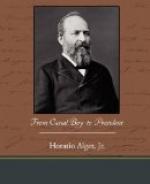His method of studying the art of war was curious and original. Falling back on his old trade of carpenter, he brought “his saw and jack-plane again into play, fashioned companies, officers and non-commissioned officers out of maple blocks, and with these wooden-headed troops he thoroughly mastered the infantry tactics in his quarters.” There was this advantage in his method, that his toy troops were thoroughly manageable.
The next step was to organize a school for the officers of his regiment, requiring thorough recitation in the tactics, while their teacher illustrated the maneuvers by the blocks he had prepared for his own instruction. He was obliged to begin with the officers, that they might be qualified to assist him in instructing the men under their command. He was then able to institute regimental, squad, skirmish, and bayonet drill, and kept his men at these exercises from six to eight hours daily till the Forty-second won the reputation of being the best drilled regiment to be found in Ohio.
My boy readers will be reminded of the way in which he taught geometry in one of his winter schools, preparing himself at night for the lesson of the next day. I would like to call their attention also to the thoroughness with which he did everything. Though previously ignorant of military tactics he instructed his regiment in them thoroughly, believing that whatever was worth doing at all was worth doing well.
He was appointed Lieutenant-Colonel, but by the time his organization was completed he was promoted to the Colonelcy.
At last the preliminary work was completed. His men, an undisciplined body when he took them in hand, had become trained soldiers, but as yet they had not received what Napoleon III. called the “baptism of fire.” It is all very well to march and countermarch, and practice the ordinary evolutions like militia-men at a muster, but how was the regiment, how was its scholarly commander likely to act in the field?
On the 14th of December orders for the field were received by Colonel Garfield’s command, stationed at Camp Chase.
Then came the trial of parting with wife and mother and going forth to battle and danger. To his mother, whose highest ambition had been that her son should be a scholar, it was doubtless a keen disappointment that his settled prospects should be so broken up; but she, too, was patriotic, and she quietly said: “Go, my son, your life belongs to your country.”
Colonel Garfield’s orders were to report to General Buell at Louisville. He moved his regiment by way of Cincinnati to Catlettsburg, Kentucky, a town at the junction of the Big Sandy and the Ohio, and was enabled to report to his commander on the 19th of December.
Then, for the first time, he learned what was the nature of the duty that was assigned to him. It was no less than to save Kentucky to the Union. A border State, with an interest in slavery, public opinion was divided, and it was uncertain to which side it would incline. The Confederates understood the value of the prize, and they had taken measures, which promised to be successful, to wrest it from the Union. The task had been committed to Gen. Humphrey Marshall, who had invaded Eastern Kentucky from the Virginia border, and had already advanced as far north as Prestonburg.




